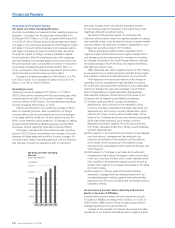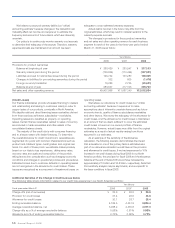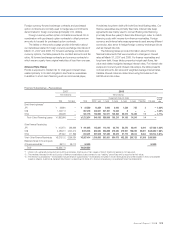Honda 2008 Annual Report Download - page 57
Download and view the complete annual report
Please find page 57 of the 2008 Honda annual report below. You can navigate through the pages in the report by either clicking on the pages listed below, or by using the keyword search tool below to find specific information within the annual report.
A n n u a l R e p o r t 2 0 0 8 5 5
or commercial paper, respectively, to investors. We retain certain
subordinated interests in the sold receivables in the form of
subordinated certificates, servicing assets and residual interests
in certain cash reserves provided as credit enhancements
for investors. We apply significant assumptions regarding
prepayments, credit losses and average interest rates in
estimating expected cash flows from the trust or bank conduit,
which affect the recoverability of our retained interests in the sold
finance receivables. We periodically evaluate these assumptions
and adjust them, if appropriate, to reflect the performance of the
finance receivables. Information about finance subsidiaries—
receivables and securitizations is described in Note 4 to the
accompanying consolidated financial statements.
Guarantee
At March 31, 2008, we guaranteed ¥36.4 billion of employee
bank loans for their housing costs. If an employee defaults
on his/her loan payments, we are required to perform under
the guarantee. The undiscounted maximum amount of our
obligation to make future payments in the event of defaults is
¥36.4 billion. As of March 31, 2008, no amount was accrued for
any estimated losses under the obligations, as it was probable
that the employees would be able to make all scheduled
payments.
Tabular Disclosure of Contractual Obligations
The following table shows our contractual obligations at March 31, 2008:
Yen (millions)
Payments due by period
At March 31, 2008 Total Less than 1 year 1-3 years 3-5 years After 5 years
Long-term debt ¥2,707,702 ¥871,050 ¥1,240,604 ¥564,916 ¥31,132
Operating leases 139,332 26,144 37,006 23,833 52,349
Purchase commitments*1122,073 122,073 — — —
Interest payments*2300,266 179,149 97,708 22,732 677
*1 Honda had commitments for purchases of property, plant and equipment at March 31, 2008.
*2 To estimate the schedule of interest payments, the company utilized the balances and average interest rates of borrowings and debts and derivative
instruments as of March 31, 2008.
Honda expects to contribute ¥28,843 million to its domestic
pension plans and ¥18,170 million to its foreign pension plans
in the year ending March 31, 2009. The Pension Protection
Act of 2006 (PPA) is effective for plan years beginning after
December 31, 2007. Certain of the Company’s subsidiaries
in the United States are unable to determine the amounts
of contribution for fiscal year 2009 because the procedures
required by the PPA have not been completed. The
contribution amounts to foreign pension plan described above
do not include the contributions of these subsidiaries.
If our estimates of unrecognized tax benefits and potential
tax benefits are not representative of actual outcomes, our
consolidated financial statements could be materially affected
in the period of settlement or when the statutes of limitations
expire, as we treat these events as discrete items in the period
of resolution. Since it is difficult to estimate actual payment in
the future related to our uncertain tax positions, unrecognized
tax benefit totaled ¥99,527 million is not represented in the
table above. Honda is currently being examined by the Tokyo
Regional Taxation Bureau (“Bureau”) on matters related to a
transfer pricing issue. In the examination, the Bureau claims
that the allocation of the total profit Honda and its Chinese
joint venture companies earned from their automobile business
in China was not an “arms’ length” allocation but rather that
too much of this total profit was realized by the Chinese joint
venture companies over the five-year period ended March 31,
2006. Honda has recognized the liability for unrecognized tax
benefits, including those related to this examination.
At March 31, 2008, we had no material capital lease
obligations or long-term liabilities reflected on our balance
sheet under U.S. GAAP other than those set forth in the table
above.
Application of Critical Accounting Policies
Critical accounting policies are those which require us to apply
the most difficult, subjective or complex judgments, often
requiring us to make estimates about the effect of matters that
are inherently uncertain and which may change in subsequent
periods, or for which the use of different estimates that could
have reasonably been used in the current period would have
had a material impact on the presentation of our financial
condition and results of operations.
The following is not intended to be a comprehensive list of
all our accounting policies. Our significant accounting policies
are more fully described in Note 1 to the accompanying
consolidated financial statements.
We have identified the following critical accounting policies
with respect to our financial presentation.
(Product Warranty)
We warrant our products for specific periods of time.
Product warranties vary depending upon the nature of the
product, the geographic location of their sales and other factors.
We recognize costs for general warranties on products
we sell and product recalls. We provide for estimated warranty
costs at the time products are sold to customers or the time
new warranty programs are initiated. Estimated warranty costs
are provided based on historical warranty claim experience with
consideration given to the expected level of future warranty costs,
including current sales trends, the expected number of units to
be affected and the estimated average repair cost per unit for
warranty claims. Our products contain certain parts manufactured
by third party suppliers. Since suppliers typically warrant these
parts, the expected receivables from warranties of these suppliers
are deducted from our estimates of accrued warranty obligations.
























